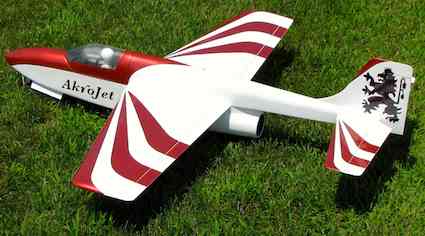 |
Flying High With Electric Power!
The Ampeer ON-LINE!
Fly the Future - Fly Electric! |
|---|
Site Table of Contents
| President: | Vice-President: | Secretary/Treasurer: |
| Ken Myers | Richard Utkan | Rick Sawicki |
| 1911 Bradshaw Ct. | 240 Cabinet | 5089 Ledgewood Ct. W. |
| Commerce Twp., MI 48390 | Milford, MI 48381 | Commerce Twp., MI 48382 |
| (248) 669-8124 | (248) 685-1705 | 248.685.7056 |
 | ||
| Board of Directors: | Board of Directors: | Ampeer Editor |
| David Stacer | Arthur Deane | Ken Myers |
| 16575 Brookland Blvd. | 21690 Bedford Dr. | 1911 Bradshaw Ct. |
| Northville, MI 48167 | Northville, MI 48167 | Commerce Twp., MI 48390 |
| 248.924.2324 | 248.348.2058 | 248.669.8124 |
| Mailed Ampeer printed subscriptions are no longer available.
The Ampeer is FREE on-line in Acrobat .pdf format and HTML with active links! | ||
| The Next Flying Meeting:
Date: Saturday, Sept. 6 Time: 10 a.m. Place: Midwest RC Society 7 Mi. Rd. Flying Field | ||
| Hitec Weekender Extra 300S ESC Instructions Found! Ken Myers tells where to find the manual with the settings for the ESC used in this ARF Extra. | How Scale Is the Weekender Extra 300S? Ken Myers looks at how scale this standoff scale plane is. | |
| The Weekender Extra 300S Stock Motor Has a Problem Ken Myers describes a motor problem he had with the stock motor. | Cobra C-2820/14 840Kv Outrunner Tested, Ken Myers shares the bench test data from this motor. | |
| Why Can't 'THEY'? Ken Myers questions why suppliers can't seem to get simple data about their products correct. | There Is Good Weather and There Is Good Flying Weather, Ken Myers Dave Stacer and Rick Sawicki take a light-hearted approach to good flying weather. | |
| ZIPPY Flightmax 4200mAh 3S1P 30C LiFePo4 Pack Report Robert Comerford describes how these LiFePO4 are working out as power system batteries. | Keith Shaw's Thoughts Regarding Efficiency and Thoughts On a POSSIBLE Next Project, Keith muses on airframe and power system efficiency and shares some photos of additional trim on his AkroJet. | |
By Ken Myers I have been enjoying flying this plane all summer. It flies well doing what I want to do with it, precision type aerobatics. My review on the Hitec Weekender Extra 300S in the July 2014 Ampeer noted the lack of information on the supplied ESC. The label notes:
I noted that I had a terrible time trying to get the power system (supplied motor/supplied ESC/4S A123 2300mAh) to work well with my Emeter II and Tactic TTX650 transmitter and TR624 receiver. If Hitec, or Multiplex, had included the programming for the ESC in the manual, I might not have asked for a replacement ESC. One June 17, I FINALLY found the programming manual on the Multiplex site. I download the manual. It notes in the manual, "The ZTW ESC is equipped with audible alert tones..." ZTW is Zone Top Way. The programming for the ZTW Beatles series is identical to the Multiplex programming, except for some of the hieroglyphics used to describe the tones. The ZTW instructions are available on their download page. The two sets of programming instructions were printed. The motor was removed from the plane and set up on the test stand. The Tactic TTX650 and TR624 were used to set the programming and the Emeter II to record the results. First, I restored the default settings on the ESC, since I'd probably messed them up when trying to calibrate the throttle without any programming instructions. The default settings and notes follow: 4. Restore factory setup defaults:
Restore- Sets the ESC back to factory default settings;
I calibrated the throttle CORRECTLY this time, according to the programming instructions. It still ran up to only about 80% throttle increasing in RPM and amps, but then dropped again. Next I changed the cell type to NiCad and recalibrated the throttle. It's a winner! The throttle moved over the complete range without a problem. With a freshly charged 4S "A123" 2300mAh pack the Emeter II captured; 11.57V, 31.7 amps, 5810 RPM and 366 watts in. I WAS ABLE to reach the power level achieved by the Castle ESC; 11.7v, 30.2 amps, 5880 RPM and 360 watts in. Programming an ESC with the throttle stick on a transmitter is a painful guessing process at best. The hieroglyphics that represent the tone codes are too hard to decipher and follow. I used a pencil as a pointer on the instructions to follow along through the various sections of ECS's tone codes on the programming instructions as they 'played' through the motor as a speaker. Had either Hitec or Multiplex noted where to get the ESC programming information, I would have had a lot less frustration. It would not have cost me time and aggravation and Hitec money to send me a replacement ESC. Since the replacement ESC is working nearly as well as the Castle Creations Phoenix Ice 50 now, I removed the Castle ESC and installed the replacement Multiplex ESC. The Multiplex programming instructions specifications for this ESC are: 50 A, Battery cell count 5-18NC \ 2-6 Lipo, BEC Output 5.5V/ 4A Why they give a weight of 32 grams is beyond me. I measured 70 grams for the weight of the ESC, wires and connectors. I noted in my review of the Hitec/Multiplex Weekender Extra 300S ARF P2GO that it is only sort of scale. I used a 3-view from F3M Aerobatics with Big Scale Models and the top view from the Hitec manual for comparison. 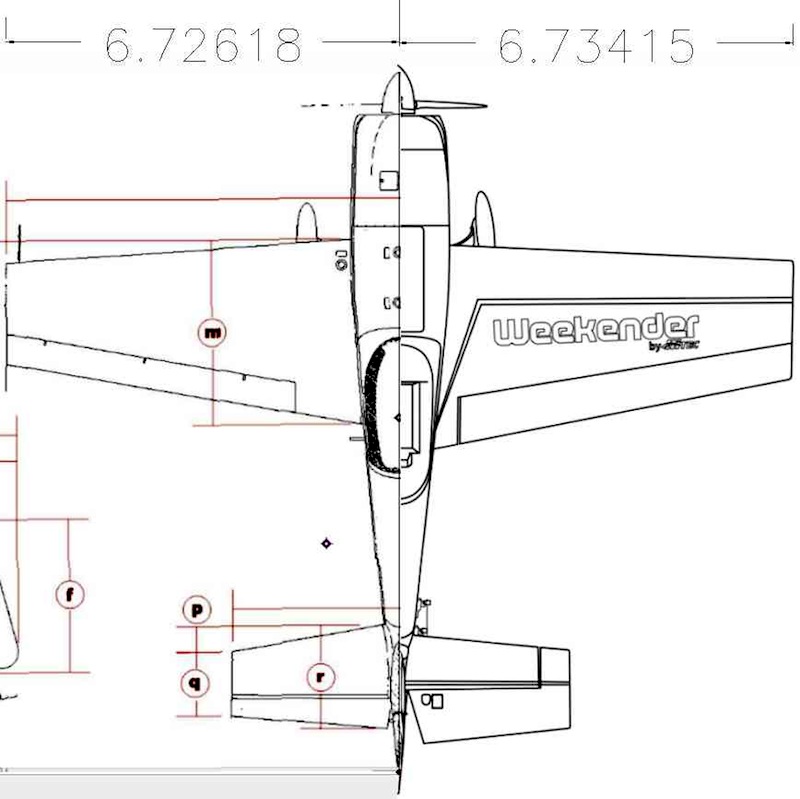 I created a top view with both wingspans being equal (or really, really close). The left side of the diagram was created from the F3M site and the the right side from the Hitec manual. I'm NOT claiming that the F3M drawing is totally accurate, but it appears reasonably accurate when compared with other 3-views and photos found on the Internet. The Patty Wagstaff Extra 300S has a wingspan of 24.6 ft. (~7500mm). If the wingspan was actually the stated 1200mm then the scale would be 7500/1200 = 6.25 to 1. Patty's stated wing area is 112.38 sq.ft. The square root of 112.38 is 10.6 / 6.25 = 1.69675 1.69675 squared is 2.8769 sq.ft. times 144 (convert to sq.in.) = 414.3 sq.in. Hitec noted a wing area of 414 sq.in. inches. I believe that this might be how they derived it. As I noted in the July review article, the measured area is really closer to 465 sq.in. On flights 26 and 27, I had a power system issue. The motor made a horrible, screeching sound while flying at approximate 2/3 throttle stick movement. On the ground, the motor stopped working and refused to rotate. It would flip back and forth a little when throttle was applied but that was it. Roger Wilfong suggested that it might be a motor short because of that behavior. It turns out that he was right. 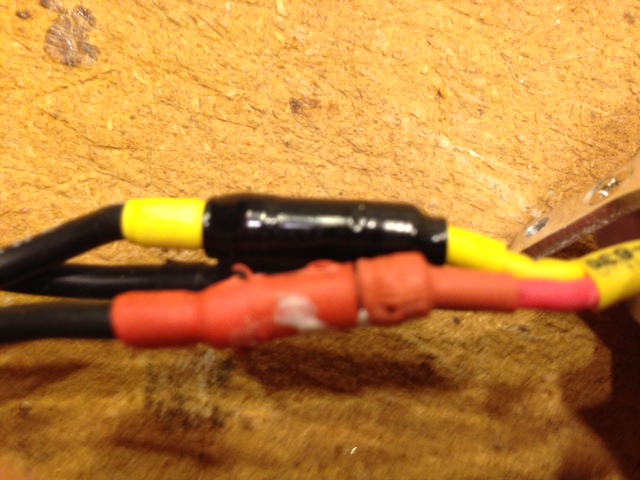 At first I thought that it might be the bullet connectors and not a short in the motor itself. The motor has extremely short, short leads of very stiff wire, which are probably the continuation of the winding wires. Two of the bullet connectors managed to get themselves very close together and appeared to allow some exposed bits of the bullet connectors to touch. Whatever the short was caused a small amount of heat to attach the two connectors together with a little melted foam from the interior. I thought that that might be the cause of the short, but it was actually the result of the short. The one bullet connector, which originally had red heat shrink on it, was fused together. Assuming incorrectly that the bullet connectors were the cause of the short, I covered the other two leads with heat-shrink tubing. I tested the ESC and motor on the test stand. It appeared that all was working fine. I replaced the bullet connector that had fused together and covered it with heat shrink tubing. The photo shows the fused connector in red heat shrink before that connector was replaced. The tears in the heat shrink were caused by my trying to take apart the connector using pliers. I thought that I had the problem fixed. At the Skymasters' Fly-in on June 28, I was only able to complete one flight. The same power system issue arose when preparing for the second flight. Once again the power system was pulled from the aircraft and placed on the test stand. It appeared that there was a loose fitting bullet connector on the black ESC to motor lead. It was 'fixed' and everything tested and seemed fine. I went flying the morning of July 4th. After about 3/4 of a lap of the flying field, the problem raised its ugly head again. Later that day, the power system was pulled and I FINALLY found the cause of the problem. There seems to be an internal short in the motor. I disassemble most of the motor, but could not get at the winds to see if it was something I could fix. I ordered a Cobra C-2820-14 840Kv motor later that day. Generically, it is a 3540-840Kv 140g motor. The supplied generic motor is a 3738-645Kv 145g. The higher Kv of the Cobra motor required a much smaller prop than the APC 14x10E that I was using on the stock motor with my 4S A123 2300mAh pack. The prop is now an APC 12x8E. At full throttle is it pulling just over 30 amps near the beginning of the pack rundown. It flies the plane just fine. There is a discussion on RC Groups regarding an even better replacement motor that will work with 3S and 4S LiPo batteries as well as my 4S A123 2300mAh pack, when an appropriate prop is chosen. The discussion also covers some Dynam airframes with a similar motor and similar motor problem. The discussion starts here at post 212. It appears that the 'best' replacement motor is the Cobra C-2862-12 760Kv. I missed that one before I ordered my new motor. Generically the C-2862-12 is a 3546-760Kv 171g motor. The mount that comes with the Cobra motor will not just 'screw into' the motor mount screw pattern on the Extra 300S's 'firewall', but the Cobra motor will mount onto the Extra 300S's motor mount. The Cobra 2826 is slightly heavier and will allow the battery pack to be moved back and and will also aid in balancing the aircraft when a 3S LiPo battery is used. By Ken Myers As previously mentioned, the Hitec Weekender Extra 300S needed a new motor. I like to use Innov8tive Designs as my supplier because of the extensive real world data provided by Lucien Miller. There is an active thread on RC Groups with more information about Cobra motors. Lucien Miller has the Cobra line of motors produced for him by Danlions in China. Danlions makes Pulso motors. The differences between Lucien's specifications and the 'standard' Pulso motors are noted in the same thread on RC Groups. I have several of the Scorpion line of motors, which are also supplied by Innov8tive designs. I have been very pleased with my Scorpion motors and have recommended them to many of my flying buddies. My test of the Cobra C-4120/18 540Kv motor was in the January 2014 Ampeer. The Static Motor Test
Externally, the Cobra C-2820/14 is a nicely finished motor. I could see the windings on the stator, and they also looked to be well done. The component weights were gathered in grams using a scientific triple-beam balance scale and the dimensions were measured. All of the weights and measures were within reasonable tolerances compared to the data posted on the Innov8tive Designs Web page for this motor. Innov8tive Designs gave the motor weight as 140g and this one weighed 140.1g or 4.94 oz. With the "+" mount and prop adapter added it weighed 153g or 5.4 oz. The motor was 'drill press' tested for Kv. A 4S "A123" 2300mAh pack was charged and then the motor data collected, volts, amps, and RPM, using the Emeter II for two no load runs and then, in this order, APC 12x8E, 12x6E, 11x8.5E, and 11x5.5E props. The elevation and atmospheric conditions of the test were; elevation ~287m, temperature ~63-deg F/17-deg C, pressure 29.85 inches and steady. Lucien noted the Io as 1 amp @ 10V. The Emeter II captured 1.6 amps @ 13.97V. The calculated Kv, using the drill press method, was 813. That is somewhat lower than the stated 840. Actually this is the largest drill press Kv difference I’ve run across recently because... After inputing the captured data into Drive Calculator (www.drivecalc.de), it calculated a Kv of 849. Here is a link to the spreadsheet with the gathered data. I decided to go with an APC 12x8E for the Extra 300S as the Emeter II captured; 11.65V, 30.6A, 7809 RPM, 356.5 watts in. That yields a pitch speed of about 59 mph. The time and effort that Lucien Miller has put into the data on his Web site is well worth it. I was able to select the correct motor for this plane on the first try. Once again it proved the value of having a reliable vendor who provides data above and beyond the others in this market! With a motor weight of 140g and 357 watts in, the watts in to motor weight ratio is 2.51:1, well below the 'mythical' 3 watts in per gram of motor weight maximum. When I did my Super Stearman conversion from an E-Flite Stearman PT-17 15e ARF, I found that the supplier had given the wing area incorrectly. The supplier stated 608 sq.in. and I very carefully measured 557.4 sq.in. Even though they were contacted, they still have not corrected this error; (posts 24 and 25). 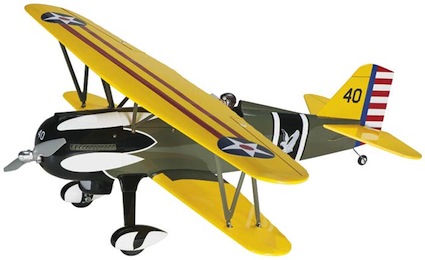
Great Planes Photo Hobbico, through Great Planes, has recently released a very sharp looking, electric powered, Curtiss P-6E ARF biplane. There is a thread about it on RC Groups. In the RC Groups thread, the supplier was called to task regarding the stated wing area of 352 sq.in. Great Planes states that the wingspan of the model is 43.5 inches. Various online sources report the wingspan of the full-scale as 31 feet 6 inches. 31 ft. 6 in. is 378 inches. 378 in. / 43.5 in. = 8.6896552. That is the scale. Wikipedia, the only source I could find online for wing area, notes the wing area of the full scale as 252 sq.ft. IF the span given by Great Planes is correct and IF the wing area stated by Wikipedia is correct, then:
IF the model is anywhere near scale, that is a HUGE difference from Great Planes' stated area of 352 sq.in. Great Planes 'big' P-6E ARF has a given span of 76 in.
Both 1/4-scale models note the wing span as 94.5 in. 1/4-scale 1
1/4-scale 2
The previous information indicates that Wikipedias 252 sq.ft. is probably in the ballpark, if the designers of the three larger planes were somewhat accurate in their designs. Further Investigation: I do not have the model, but I wanted to use the method where the wing is outlined on sheets of printer paper and the weight of the wing panels is used to calculate the wing area. I used a cropped graphic from Tower Hobbies Web site. 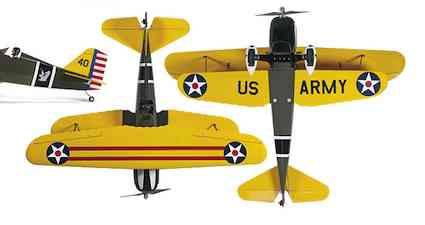 I imported the graphic into my CAD program and traced it. I then enlarged the drawing so that the wing span was 43.5 in. 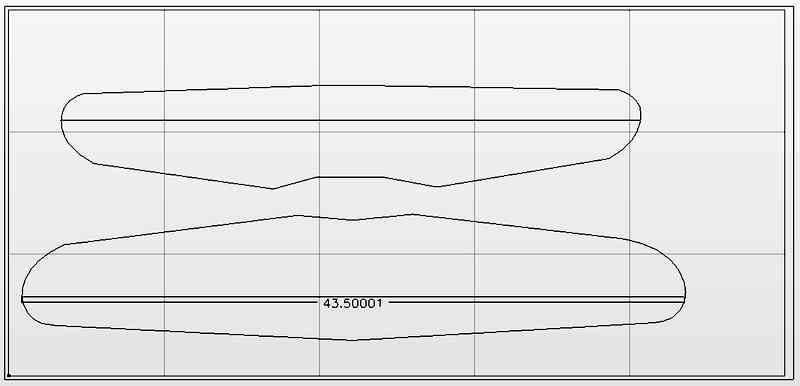 I weighed, using a scientific triple-beam balance scale, and measured, with a ruler, 15 sheets of printer paper.
I cut the wing areas from the printed paper and weighed them. 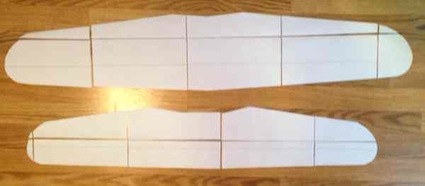 Top Wing: 13.75g / 0.0488375g per sq.in. =
281.5 sq.in.
Based on all this information, I believe the model's wing area to be between 480 sq.in. and 490 sq.in. If I had the actual model wings in hand, I could confirm this. Conservatively using 480 sq.in., the area loadings, based on Great Planes' ready to fly weights are:
Those numbers are significantly different from the wing loadings of 25 oz./sq.ft. to 29 oz./sq.ft. noted by Great Planes. Wing Cube Loading Factors: Wing Cube Loading Factor 60 oz. = 6.0858062 = factor 9.86 (typical at the high end of the sport/sport scale category) Wing Cube Loading Factor 72 oz. = 6.0858062 = factor 11.83 (typical for advanced sport/sport scale plane) The August 2014 issue of Model Aviation had a review of this plane starting on page 50. The author, Tom Sullivan, appears to 'parrot' Great Planes data for the wing area at 352 sq.in. as there is no mention of him verifying it in the brief article. Tom also noted the ready-to-fly weight but without the battery pack, "The aircraft weighed a respectable 3.25 pounds without the battery." 3.25 lb. is 52 oz. He never stated the battery pack weight in the article. I had to look it up online and found that the ElectriFly 3S 2200mAh 30C LiPo battery weighs 6.1 oz. That brought his RTF weight to 58.1 oz. or 3.63 lb. That is just slightly under Great Planes minimum noted weight. While the power system components, that Tom used in his version, are noted in the article, none of the important power system information regarding volts, amps, watts in and RPM were given. I still wonder, "Why can't 'they'?" A measured wingspan showed up in the previously noted RC Groups thread. It is in post #33. The measured wingspan is given as 1100mm or 43.3 in. That reduces the wing area only slightly from my previous calculations. Electric Warbirds: P-6E Hawk biplane fighter - New 43" EP from Great Planes Michael Heer's review of this plane should be posted any day now on RC Groups. By Ken Myers, Dave Stacer and Rick Sawicki This is being written the last week in July here in southeastern Michigan. The weather has been beautiful. Highs have only been in the upper 70's all week. There has been some rain on and off, but the mornings have been pretty dry. Unfortunately, it has not been good flying weather. It has been way too windy most of the time. I spend a lot of my time at the flying field training. We need low to low-moderate winds for training. It has almost been impossible to 'schedule' any kind of flight training. EFO members, and my very good flying buddies, Dave Stacer and Rick Sawicki just exchanged a couple of emails regarding the 'weird' weather and weather prognosticators. They illustrate another problem with trying to get in some flying time. 7/26/2014 from Dave Stacer Today the Weather Rock was 100% accurate. The weatherman was completely wrong, at least for our flying field. Looking at the weather report last night and this morning, they were predicting 10-15 mph winds and thunderstorms for today (Saturday). This morning I had no plans to go flying because of the weather report. Then around 10:00 it was nice, sunny and hardly any winds. I loaded up and went to the field expecting only to get a marginal few flights in before the rain started. 4-1/2 hours later I had my fill of flying. Still no rain, lots of sun and the crosswind was gusting somewhat. Arthur (Midwest president Arthur Deane - KM) was also there with me. We had the field to ourselves. I mentioned to Arthur that the weather rock was accurate and the weatherman was completely wrong. Arthur was not familiar with the weather rock concept so the following article is very informative. Today the weather rock was not wet and was not swinging. I think I'm going to pay more attention to the weather rock and less to the weatherman. The Fusion 380 got three very successful flights today too. 7/28/2014 from Rick Sawicki Hi Dave, I just had to resurrect your e-mail and can very personally relate to it today, especially regarding just how WRONG the weather forecasting can be. Today at noon it was very cloudy and I wanted to cut the grass here at home. I checked 5 different forecasts. ALL 5 said that there was 0 chance of rain. I started to cut it around 2. Guess what? At 2:30, with the grass was half cut, a passing cloud dumped a ton of rain on my 1/2 cut grass, me and my Deere. That shows what the weather forecasters know. However, I checked "my weather rock" in the backyard in a flower bed. I put one in the day after reading your e-mail. Guess what? It was wet, so I quit for the day. Weather forecasters get an "F" and the weather rock gets an "A". Rick On the same day that Dave enjoyed a great flying day at our home field, Keith Shaw, Denny Sumner and I had been in contact on the preceding Friday regarding Saturday's weather. We were planning to attend the WOW meet, 50 Miles to our northeast. The forecast looked ominous. We made the final decision to go early Saturday morning. We also enjoyed the same great flying weather that Dave experienced. It sure makes you wonder about forecasters. We should have consulted the weather rock, and all would have been well. From Robert Comerford - Australia via email
Hi Ken, I'd like to update you on our adventures with LiFePO4 packs. One of our group, Doug Hall, has equipped his E-flite Ultra Stick 25e with the following power system.
This combo regularly returns flights around 20 minutes, mostly being thrown around :>) The meter suggests 510 watts in at 29A. We are above 3500 ft (1070 Metres). Doug had to make some minor mods to the battery compartment to shoehorn them in. Hope you are all getting some flying in. Regards, Bob Comerford - Australia  Thanks for the info Bob. 510 watts in / 29A = 17.586207V / 6 cells = 2.93V per cell. That is pretty close to what an A123 2300mAh cells can do at 29A/30A. I'm seriously thinking of looking into them now. From Keith Shaw Via Email This last weekend I flew an air show under very threatening skies. The flights went well and I documented the times and returned capacity in order to estimate actual power use while doing energy management aerobatics. Stomo: 28% scale model of the rare 1932 German homebuilt. 85" span, 1180 sq.in., 7.3 lb., eight A123-M1A and a Hacker A40 motor, 15x10 prop, 600 watts in WOT (wide open throttle KM). The 8.5 minute routine used 1.570 Ah out of the 2.1 Ah cells. Calculated average current = 11 amps, and average power = 267 watts in. That's 82 watts in per lb. peak and 37 watts in per lb. Sausewind: 1/5th scale of the even rarer 1925 German racer. 71" span, 780 sq.in., 6.5 lb., seven A123-M1B cells on Cobra 3525, 15x8 prop, 450 watts in at WOT. The 6.5 minute routine used just 0.926 Ah out of the available 2.5 Ah cells. Calculated average current = 8.5 amps, and average power = 180 watts in. So 70 watts in per lb. peak and 28 watts in per lb. average. Nomad: 1960s Ted Strader design flying with its original Adams magnetic acuator, Astro 010, 6x4 prop, two small A123s rated at 1.1 Ah. The 10 minute flight consumed a whopping 174 mAh. Calculated average current = 1.0 amp, average power = 6 watts in. And by the way, I think the actuator current is 200 mA, so the real average motor current was 0.8 amp, and the flight power about 4.8 watts in!!!!!!!! Even though I didn't fly it, I thought I'd add one other to put it all in perspective. CzechMate is 1/6th scale, 62" span, 10 lb., Astro Monster motor on ten 5.0 Ah LiPos, turns a 16x16 prop at 11k+ at 4200 watts in (38 volt x 110 amp). I go through 4 Ah in 6 minutes, so the average current is 40 amp and 1500 watts in. 420 watts in per lb. peak and 150 watts in per lb. average. This got me thinking, how big of a plane could you fly with a "normal" power system? I consider the upper end of my budget to be something like a 10s2p pack of A123s. The other thing that has me pondering is the "inheritance" of an Astro brushless 60, a handful of good sized carbon tube, and the itch to experiment with some alternative building methods that have been rolling around in my brain for a few years. As a baseline, the Bearcat uses a 10s2p A123 pack on an Astro 60 with a belt drive, pulls 50 amp WOT, weighs 15 lb. It does effortless vertical aerobatics, and easily flies for 10-12 minutes with capacity left. 1500 watts in WOT, but about 20 amp and 600W average. So 100 watts in per lb. peak, but 40 watts in per lb. average. The thoughts of a BIG Waco INF have me pondering. The INF was a later "simplified" plane for the budget market, designed to help WACO stay aloft during the Great Depression. It had no fillets, no cowl, no wheel pants or complex shapes, a functional articulated landing gear, and a simple cup over the crankcase. With a relatively short fuselage and oodles of wing area, even a huge model could fit in my car with all four wing panels unplugging, plug on stab, and functional Aramid rigging. Also Airborne Models (makers of the Toughlon covering that I used on the Sausewind and many others) offered to give me whatever covering I need for new projects. Assuming 1500 watts in and 60 watts in per lb., gives 25 lb. (400 ounces) and for a good biplane I use a max cubic loading of 6, implying 67 "cubic feet" or 16.5 sq.ft. (about 2380 sq.in.). This is the smallest necessary to meet the handling requirements. That's 1/4 scale for the Waco, span 90", length 62.5, prop 21", 24 oz/sq.ft. Power system and radio would be about 100 oz. Quite ordinary these days. I'm thinking more along the lines of 1/3 scale, 120" span, fuse length 83", prop 28", area 4200 sq.in. At 25 lb., 14 oz/sq.ft. or a wing cube loading factor of 2.53. World's Largest Parkflier... I think if I really am careful (and creative) with the structure I could still make the 25 pounds. The removable wing panels are all about 48" span, and the 83" fuse would fit in my car with a good safety margin. The stab definitely would need to be removable as it would be a 44" span! The INF did not have a stab fillet, and the stab trim/attachment is much like a J-3 Cub. We're not talking "high" scale, no fabric finish or rib stitching. Basic stick box fuse, foamboard bulkheads, dowel stringers, flat tail surfaces, Clark Y on the wings, maybe foamboard ribs, film covering. Homemade belt drive for the large prop, and all the cells wrapped around the drive under the crankcase cap to get the CG right. Servo in each wing panel and each stab half to minimize linkage weight. Articulated landing gear out of carbon tube. Probably heaviest component would be the wheels. This was a pleasant diversion from packing for my slope-week at the Dunes. More later as I brainstorm while Up North. Keith
I thought I would send along a few photos of the AkroJet with the "enhanced" color scheme. While it flew well, there were times that the mostly-white plane simply vanished from my sight. Scary. Hope the additional markings make it a little more visible. Waiting for the endless high winds to die down. It has been hot and muggy with 20+ mph (cross)winds every day for about a week. Tomorrow shows promise. Take care,
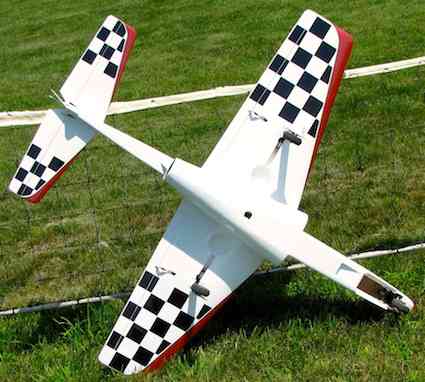 |
To Reach Ken Myers, you can land mail to the address at the top of the page. My E-mail address is: KMyersEFO@theampeer.org

